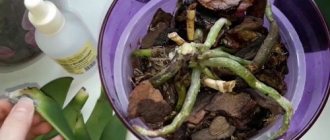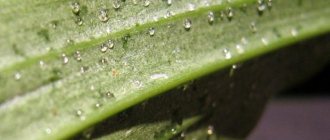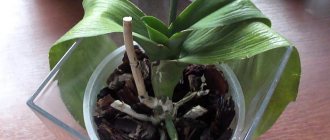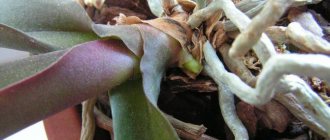It is difficult to argue with the beauty of an orchid, but sometimes it is overshadowed by cracked leaves that suddenly make themselves felt. A similar problem arises suddenly, and to solve it you need to know why the orchid’s leaves are cracked.
Usually there are several reasons. The most common of them are:
- Mechanical damage.
- Error with flower placement.
- Insufficient amount of root system.
- Incorrect temperature.
- Dry roots.
- Excess moisture and fertilizers.
Each problem requires an individual approach so as not to further harm the flower.
Mechanical damage
It's hard to believe that dense and strong leaves can crack, but this actually happens. This happens either due to a violation of natural biochemistry or due to mechanical interventions. As for the second option, it is encountered much more often. It happens that a leaf plate was touched during watering. The gardener did not immediately pay attention to this, but later noticed that the leaf was cracked.
Typically, such damage is located in the middle of the leaf plate. If the sheet does not bifurcate, you do not need to do anything about it, since the plate will be covered with mechanical fabric. If it literally breaks into two parts, then the surface should be treated with an antiseptic.
What to do with the plant if the leaves of the orchid crack
If you have had the plant for a long time and you are confident in the strong root system of the orchid, then you should not replant it. If you bought an orchid where the leaves bifurcate in half, then it is advisable to replant it as soon as possible in fresh soil. Phalaenopsis will feel great in well-ventilated soil. It is classically customary to plant orchids in pine bark.
Before planting, inspect the orchid's roots. It is better to remove dry roots. Roots with signs of rot must also be removed. Don't overdo the root trimming. If only small points of the roots are affected by blackness, then it is better to leave it. Treat the roots with a fungicidal preparation.
After planting, water the plant. Do not use fertilizers at all for 3-4 months. Purchased bark is already equipped with fertilizer. In this situation with cracks, there is no need for extra feeding.
If the roots are green and strong, then continue moderate watering. It is better to water once every 4-7 days. The degree of watering will depend on the room temperature, lighting and air humidity. Do not forget to spray the phalaenopsis at least once a week.
Wipe the leaves with a damp cloth. Use ordinary water, you can settle the water. Also do not use leaf additives if your orchid's leaves are cracking.
It will be possible to fertilize an orchid with cracked leaves only after it produces a new leaf. If the new leaf does not have a crack in the middle, then fertilizing can be resumed. If the new leaf cracks, and this is not uncommon, then you cannot feed the orchid yet.
Insufficient root system
Frequent transplants and diseases lead to the plant losing its roots. As a result, it turns out that the root system that exists is simply not able to ensure the health of the entire green mass of the flower. Lack of nutrition leads to cracks. In this case, you can cut off some leaves so that the situation will improve soon when new roots grow.
Important! Leaf blades need to be trimmed only when all other reasons have been excluded.
Care after fixing the problem
After the cause of the cracks has been identified and eliminated, the leaves must be cared for in a special way so that they recover as quickly as possible:
- It is very important to take care of the prevention of bacterial and fungal diseases that can penetrate through the crack. To do this, you need to regularly wipe them with antiseptic agents.
- If the leaf blade has burst recently, there is no need to wet it at first. Until the “wound” dries out, all sprays and showers stop.
There are many problems that lead to cracking of orchid leaves, but to get rid of them, you just need to follow the rules of caring for the plant. This is what will prevent problems from occurring and ensure the health and beautiful flowering of the orchid.
Incorrect temperature
The mechanical fabric of sheet plates is weakened not only by exposure to bright sunlight, but also due to sudden temperature changes. Therefore, if the room was warm, and then the air temperature suddenly dropped by 6-7 degrees Celsius, then it is not at all surprising why the orchid’s leaves cracked.
Usually, when something like this happens, the entire appearance of the orchid changes. Flowers may begin to fall off and leaf blades may turn yellow. Therefore, it is necessary to choose a place for the plant where the temperature indicators would not fluctuate, being constantly at the same level. Only minor errors are allowed.
Why is this happening and what to do?
A leaf plate divided in two is a downright unusual phenomenon . Although any gardener can face a similar problem. Of course, if everything is due to a natural process or the carelessness of the owner, then everything is clear. And if young, healthy orchid leaves suddenly begin to crack, then you should look for the cause and act.
Mechanical damage
It's hard to believe that powerful leaves can break. This can happen in different situations: during transportation, watering, sudden change of location or transplant. The florist may not immediately notice the injury. Usually the injured part falls on the center of the leaf plate.
Measures taken:
- If a shallow scratch appears, it will most likely be covered with mechanical cloth.
- However, if the sheet is split into two halves, then in order to prevent and prevent the process of rotting, this place should be treated with an antiseptic solution.
We recommend watching a video about cracks on orchid leaves due to mechanical damage:
Excess nitrogen
Frequent use of nitrogen-based mineral fertilizers does a lot of harm. When a plant is overfed with nitrogen, in addition to cracked leaves, there are other corresponding symptoms:
- the leaf color becomes dark green;
- the leaf plate lengthens;
- the surface becomes corrugated, wavy (why have the orchid leaves lost their turgor and wrinkled?);
- the green mass becomes juicier, thicker, and there is no flowering.
Measures taken:
- We exclude nitrogen fertilizers from the orchid’s diet.
- Remove the plant from the pot.
- We clean the roots and soak them in warm water.
- Let's give it time to dry.
- We update the substrate and move the pot to a well-lit place.
- Eliminate mineral fertilizers completely for 3 months.
- After a while, carry out a course of treatment with potassium fertilizers, once a month for six months.
Overdrying of the root system
This reason is the most common. Perhaps because orchids love warmth very much. But everything is good in moderation. Due to lack of moisture, the leaves move apart and cracks appear. In addition, the foliage becomes lethargic and flabby (why did the leaves become soft and flaccid?). Do not leave a flower pot near radiators or under ultraviolet radiation during cold periods.
Measures taken:
- Move the orchid to a room where the temperature is lower.
- Allow to recover for 2-3 hours.
- Moisten at the root and spray the leaves.
- The flower restores water balance for up to 5 days.
Few roots
After suffering from a disease or pruning during replanting, the exotic plant loses a large number of roots (read about how to save a flower without roots here). And subsequently the plant is unable to feed the powerful, large leaves. So they start to burst. The best way out of the situation is to remove part of the green mass.
Measures taken:
- Disinfect pruning tools.
- We remove damaged foliage, and, if necessary, healthy foliage.
- Sprinkle the slices with activated carbon and ground cinnamon.
- We isolate the plant and let it remain in quarantine.
- Do not fertilize the soil for the first 2-3 weeks.
- Moisturize once a week, not more often.
Over time, the roots will grow and new young shoots will appear.
Quick cooling after watering
When caring for orchids, you need to be especially careful in winter. It happens that after moistening, cold air hits the flower when the wet plant is taken out to the balcony, a window is opened for ventilation, or placed on a frosty windowsill. Hypothermia is quite a dangerous phenomenon. Since the vessels passing through the center of the leaf plate and to the roots are destroyed. Stimulates similar development of rot diseases.
Measures taken:
- With the arrival of cold weather, it is worth measuring the air temperature near the window. If it turns out to be below +17-18°C, then there is no need to leave the orchid there. She should find somewhere warmer.
- It is also important to exclude drafts, and after moistening it is advisable to wipe the leaves dry.
Low air humidity and high temperature
The combination of these parameters leads to negative consequences for the orchid. If it is located in a room where the sun shines brightly and the temperature is high. Of course, the flower is hot, and a large volume of liquid evaporates from the green mass. In addition, an exotic plant cannot be fully saturated with water, which results in cracks and tears in the green leaves.
Measures taken:
- It is recommended to spray the leaves daily.
- Place the orchid pot in a cool room.
Large temperature difference
Cold air may be to blame for the appearance of cracks on the sheet plate. When transporting orchids home from the store, in contact with cold glass or air infiltration. If the temperature difference is more than 5°C, this will have a detrimental effect on the orchids.
Important : Hypothermia turns into a forced form - the exotic slowly gains green mass, drops buds, cracks, yellow spots, and signs of lethargy appear on the leaves.
Measures taken:
- Deformed leaves and damaged buds cannot be treated and should be removed.
- Transplantation should not be done either. Just move the pot to more comfortable conditions and moisten it regularly.
Caring for broken orchid leaves
Burrowing orchid leaves require careful attention and regular inspection. The resulting cracks become open entrance gates for any infection. Therefore, the prevention of fungal and bacterial diseases in such a situation should come to the fore.
It is not advisable to wet recently burst leaves with water. Any showers and spraying should be temporarily stopped until the wound dries. A fresh crack can be treated with brilliant green or another antiseptic, and the orchid itself can be treated with a fungicide from time to time.
“One of my phalaenopsis kept bursting until I changed the fertilizer. Now I use “Bona Forte for orchids” from the “Beauty” series. The new leaves grow normally, but the old ones still stand broken in half. To avoid any sores, I treat them with “Fitosporin” and gradually water them with “Trichodermin”. Phalaenopsis is alive and well, blooming magnificently and regularly” (Lana, Krasnodar).
Sudden temperature change
Orchids are temperature sensitive. Changes in night and day temperatures of more than 5 degrees can have a bad effect on flowering and appearance.
This, by the way, is another argument not to place the flower on a sunny window. After all, during the day it will be about 40 degrees behind the glass, due to the scorching direct sun and the greenhouse effect, and at night the temperature will drop to an average 20 degrees. Of course, such differences are critical for the health of phalaenopsis. Under such conditions, it is not surprising that the sheet splits and cracks in the middle.
But other situations are also possible in which the temperature will change sharply. For example, in winter, in some rooms the heating is turned on only at night, or vice versa, during the day when there are people there. This is done in order to save money, but this is not suitable for the orchid. In this case, she will need to find another place.
Determination of leaf cracking
Orchid leaves are strong, leathery, elastic . But the sudden appearance of cracks occurs as a result of mechanical damage or disruption of biochemical processes. It is important to remember that external defects reflect internal ailments of the flower. The outwardly ugly phenomenon has the following appearance: the fracture runs along the central vein of the leaf. Moreover, the crack can begin either from the stem or from the tip.
ATTENTION : Mostly the lower leaves of the orchid burst. At the same time, the leaf exists fully, it does not turn yellow, does not dry out or rot, but still spoils the overall picture. I would like to understand the reasons and eliminate unfavorable factors.
Why does this happen?
This kind of deformation is stressful for the plant, because the integrity of the tissues is disrupted, and, consequently, the exchange of nutrients. Also, the flower loses its healthy appearance, which directly worries the grower.
Let's look at why cracks appear in the middle of the leaf, dividing the leaf in half . Main reasons:
- waterlogging;
- excessive use of mineral fertilizers;
- wrong location;
- insufficient watering;
- unfavorable air parameters (temperature, humidity);
- mechanical damage;
- a small number of roots;
- diseases of the root system.
Watch a video about the reasons why cracks appear on orchid leaves:
Why orchids? Interesting facts: why the buds of the phalaenopsis orchid dry out
Provided with everything, growing in close to natural conditions, the plant always looks healthy and blooming.
And even in cramped home conditions it is able to survive. Although modern hybrid forms of orchids are so demanding of approximate conditions and are quite tenacious, cultivation is not without problems for the grower.
One of these problems is when they start.
, but almost all of them are associated with either incorrect or inappropriate conditions of detention.
The plant experiences stress mainly due to...
blooming, whose flowers and buds began to dry out after a couple or three days, sometimes.
So why do orchid buds wither under certain conditions?
The orchid is accustomed to certain conditions of existence and suddenly not only the situation changes, but also... Of course she will be stressed.
The main thing is not to purchase a sick plant that has problems with the root system or any problems.
It would be good to find out from the seller what pre-sale prices are.
Particular stress is experienced when moving long distances during the cold season. No matter how you wrap it up, it will still happen three times in a short period of time, causing a stressful state. Which naturally entails, since energy is spent on maintaining life.
When transporting in the cold season, it is especially necessary to protect the root collar.
Change of conditions of detention
A sudden change in conditions is also stressful.
If the conditions in a store and an apartment are not so different, then when purchasing a plant in a greenhouse, the conditions change dramatically.
The pet begins to experience a sharp lack of lighting, temperature conditions, and completely different humidity.
Even a person will find it difficult to adapt to other living conditions when changing tropical conditions to a completely different natural and climatic zone.
It takes a certain amount of time to adapt.
Withering of buds can occur whenever a flower moves to a new room. But there's nothing wrong with that.
If the plant is healthy, then adaptation will be successful and will please the grower for a long time.
Lack of lighting
The reduction in daylight hours, which is observed especially in the autumn-winter period, reduces the production of the main “building material” - glucose.
As a result, the buds do not have time to ripen, and gradual withering and drying occurs first, then the flowers, etc.
Phalaenopsis requires 12 hours of daylight.
Many gardeners use fluorescent lamps to provide the necessary lighting for orchids in winter.
If at the beginning of autumn you can ensure the required duration of illumination by moving it to a more illuminated side, then in the future it is best to purchase a phytolamp.
Lacking a pronounced state of rest, phalaenopsis will need additional lighting in winter.
In this case, it is the phytolamp that can provide at least 10 hours of daylight for him.
Recommendation! Of course, you can move it to another room, but do not forget that orchids do not like sudden changes, which can cause stress, causing several buds to wither or drop.
Temperature jumps
Small temperature changes, on the contrary, have a beneficial effect on flowering for this type of orchid.
Only a prolonged decrease to 14°C and a prolonged increase above 40°C have a negative impact on budding and flowering.
Most often, overheating a plant causes sunburn or heatstroke.
If in the summer it is the sun, then in the winter overheating can occur from a hot battery, convector or heating device turned on nearby.
The evaporation of moisture from the leaves significantly exceeds its supply and a stage of dehydration occurs, which entails wilting and yellowing of the buds.
Irrigation with cold water on hot summer days also has a negative effect on development.
Dry air
Tropical plants are characterized by a certain environmental humidity.
Although this type of orchid, such as phalaenopsis, is not particularly demanding on air humidity, when it drops below 30%, it still causes a deterioration in the general condition.
It’s even worse when the room temperature is high at low humidity. In most cases, this happens when the heating is turned on in the autumn-winter period.
This situation stimulates increased evaporation of moisture by the leaves, and the root system cannot compensate for it in the required volume.
The missing moisture is extracted from the tissues and, as a result, the plant itself becomes lethargic, the flower stalks wither and dry out.
Prevention measures
After the plant has been restored, it is important to prevent further deformation of the leaves. To do this, follow simple preventive measures:
- The temperature in the room is not higher than + 22 degrees. C and not lower than -18 degrees. with air humidity up to 60%;
- water when the soil dries out, prevent cracking of the soil, use warm water after filtering,
- the leaves are sprayed every day;
- pots are placed in places with diffused lighting, away from radiators;
- the premises are ventilated, do not allow cold currents to reach the sprouts, and protect from drafts;
- fertilize no more than 2 times a month;
- standardize nitrogen fertilizers;
- When flowering, potassium and phosphorus fertilizers are used.
If a damaged leaf is noticed in time, then measures will be taken in a timely manner, and the orchid will quickly restore its appearance.
Improper watering of an orchid - excess or deficiency
Although with a lack or excess of moisture, the leaves burst for various reasons, but clearly, both are not acceptable when caring for phalaenopsis.
With excessive watering, the leaves crack because they are overwhelmed with moisture, and they do not have time to grow and stretch. Many people know that this happens to root crops when overwatered. For example, carrots crack right in the ground if they are watered too much. The same thing happens with orchid leaves.
It should be noted that in practice, cracking from overwatering occurs much less frequently than from drought. Usually the roots are the first to react to waterlogging. They begin to rot and deteriorate if the substrate does not dry out and remains constantly wet.
Returning to the natural conditions for the growth of orchids, let's say that a tree or other plant on which a flower grows in the wild cannot always be wet. Orchid roots need air and take moisture from it, among other things.
But lack of watering is a common cause of cracks in leaves. Everything is easily explained, because they begin to dry out, and cracks form in the dried places.
What to do?
The appearance of an unhealthy leaf can itself tell about the disease that has affected it. Various negative factors each have their own effect on the condition of the leaf plate. So most often the problem can be identified by carefully examining and feeling the leaf.
Methods for eliminating painful conditions also vary. Therefore, in order to understand how to act in a particular case, you need to know what these or those symptoms mean and what causes them.
If the leaves curl?
To return the leaves to their normal shape, you need to find out why the deformation occurred. Causes of leaf curling can be:
- insufficient watering;
- low temperatures;
- frequently turning the pot towards the sun;
- dry air;
- excess or lack of fertilizers;
- attack of whiteflies, aphids, scale insects.
To revive the plant, it is necessary to treat it with insecticides and organize a normal watering regime without fertilizers. Place the plant in a warm and humid place, perhaps with artificial light, for 10-12 hours.
What if they start to crack and burst?
Orchid leaves can crack only in two cases. Either this is mechanical damage or a violation of biochemical processes.
If the first is excluded, then the second may be due to:
- excess or lack of fluid;
- oversaturation with nitrogen;
- overdried root system;
- sunburn;
- root system problems.
To restore leaf blades, it is necessary to normalize the watering and fertilizing regime. Remove the plant from the sun and carefully examine the condition of its root system.
If they're flabby?
Flabbiness of the leaves is one of the signs of an unhealthy flower. Factors that cause sagging are most often:
- violation of watering rules;
- overheating of roots;
- root damage;
- increased soil density.
To cope with the problem of sagging leaves, you should adjust the plant’s drinking regime and regulate the temperature situation. Carry out a thorough inspection of the substrate and root system, and replant if necessary.
If they split?
Forking a leaf in an orchid is quite rare. There are also few reasons for this: either it is the incorrect growth of the new leaf, due to its attempts to stretch towards the light source. Or perhaps this is a consequence of an overdose of nitrogen, which leads to various deformations.
In order for the leaf to have a normal shape, it is advisable to unfold the pot so that the light falls from the desired side. The feeding schedule should be reviewed.
What if you got sunburned?
Sunburn occurs in a fairly short time, so leaving the flower in the sun, especially in spring or summer, even for a short time, is not recommended.
Symptoms of sunburn:
- increase in temperature of the sheet plate;
- lightening leaf color;
- the appearance of pigmentation and spots with a brown edge.
If the burns are severe, the leaf is cut off; if there are not very many marks, then you can leave it and observe it. If completely yellowed, it will have to be removed. Fertilizing during recovery should be excluded, watering should be limited, and diffused light should be provided.
What if they become soft?
Soft leaves are a fairly common problem in orchid plants. The main reasons for softness are:
- problems with watering;
- diseases of the root system;
- tick invasion.
To restore the elasticity of the foliage, it is necessary to normalize the watering system. Carefully inspect the plant for parasites and rotting of the root system. Carry out the necessary treatment.
If small leaves don't grow?
There may be several reasons for the lack of leaf growth. The most important negative factors are:
- improper watering;
- incorrect temperature conditions;
- insufficient lighting;
- unsuitable humidity level;
- lack of potassium and phosphorus.
To stimulate leaf growth, it is necessary to normalize the main indicators of the orchid's conditions. Feed the plant foliar.
Expert advice on preventing leaf cracking in orchids
In order not to solve problems with bursting leaves, it makes sense to listen to the advice of an expert in the field of indoor plant growing:
“Misunderstandings with cracks along the leaves of orchids arise for one main reason - improper feeding. It is necessary to establish this process as soon as the plant enters the house. You should not blindly use the instructions on fertilizer packages - they do not take into account a number of individual factors and most often lead to overfeeding orchids. But you can’t completely give up feeding. We need a golden mean. The most win-win tactic is to reduce the recommended dosage by half and coordinate the frequency of feeding with the phases of the orchid’s growing season.”
L. Eroshina, agronomist, landscaping specialist
Places where cracks appear on orchid leaves
Before you begin diagnostics, you need to carefully examine the plant and check where cracks appear. Localization is of great importance to correctly determine the cause:
| Location of cracking | Symptoms | Probable Cause |
| In the center of the plate along the central vein | The crack is small, wet, and does not affect the top of the sheet or its base. | Recent short-term disruption of irrigation and fertilizing regimes |
| The crack is large, wet, the sheet completely bursts in half and bifurcates. | Constant gross violation of fertilizing and irrigation regimes | |
| On an old sheet, the crack is dry, not through, long or small, and does not affect the general condition of the sheet. | Long-term short-term violation of the irrigation and fertilizing regime. | |
| Along the top of the sheet along the central plate | A bursting forked top is observed both on old leaves and on young, growing ones. | Chronic imbalance of nutrients, violation of feeding regime. |
| At the base of the leaf | Transverse dried crack surrounded by yellowed tissue | Mechanical damage to the sheet |
| Anywhere on the sheet plate on the top or bottom side | Non-through cracking, accompanied by plaque, stains and yellowing. | Infectious diseases or pests |
| Small dry spots and cracking that do not affect the overall condition of the sheet. | Traces of healed mechanical damage, wounds or sunburn. |
Thus, based on the nature of cracking, preliminary conclusions can be drawn about its causes. After this, you need to begin a more in-depth analysis, and then treat the plant.











